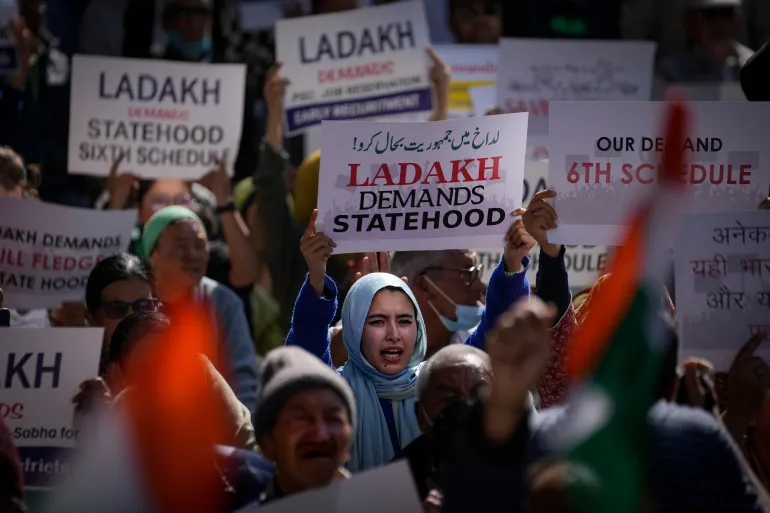While I sit on my patio in sunny Berkeley writing this, it’s below freezing in the mountains of Ladakh, where people lay beneath the open sky – hungry, hopeful, and in solidarity with the glaciers.

(Source: Photographer Hans-Jurgen Mager, Unsplash)1
Sonam Wangchuk, an innovator, climate activist and education reformist, is observing his 13th day of the #ClimateFast2, along with 250 others. Wangchuk has declared a ‘fast unto death’ in 21-day phases, but the government does not seem phased and the media not as engaged in covering this story, considering India’s dwindling democratic freedoms.3
“Twenty-one days – because this is the longest fast that Mahatma Gandhi kept during the Independence struggle, and I want to follow the Mahatma’s path where we inflict pain on ourselves, so our government and policymakers notice our pain and act in time,”
Sonam Wangchuk in his March 6th address4
This climate movement draws attention to Ladakh’s ecological crisis, marginalization of local indigenous peoples, and the relational geographies of the climate crisis – with those contributing the least, being affected first and worst.
Most importantly, this is a movement calling for the restoration of truth, environment, and democracy in India.
So, what are the asks from this Gandhian inspired passive resistance?
Ladakh, a Union Territory, requests to be considered under the Sixth Schedule of India’s Constitution5, reflecting people’s concern with regards to their land, livelihood, and indigenous culture. Alternatively, Wangchuk requests Statehood. This will allow for local representation in governance. Additionally, it will protect the land and livelihoods of the indigenous peoples of Ladakh. Right now, all decisions are made by the center in New Delhi with NO LOCAL REPRESENTATION from Ladakh.
On August 5th, 2019 – Ladakh received the status as a Union Territory independent of Jammu and Kashmir. The government has been promising the people of Ladakh representation ever since, however, they have failed to deliver.
On March 6th, the final negotiations ended with no results and the people of Ladakh took to the streets in protest.
Ladakh consists of a 97% tribal population6 and conserving these indigenous cultures and supporting the stewardship of this ecologically fragile region in the midst of the climate crisis, is crucial. The Ministry of Tribal Affairs wrote a letter in 2019, recommending the governance of the region under the sixth schedule.
Protests in New Delhi (Source: Altaf Qadri/AP Photo)7
Since the center taking over control of Ladakh’s governance in 2019, the number of infrastructure projects proposed in the region is unprecedented with several projects being unsuitable for the local context. For example, hydropower projects. The extreme temperatures cause the water to freeze in the winter, with subsequent siltation in the summer. Despite the flaws, 7 hydropower projects have been proposed on the Indus River. All this without democratic process and representation from the people that understand the context, these lands, and the fragility of this ecosystem best. Equity? Environmental Justice? All terms completely absent from the autocratic relationship between India’s capital and Ladakh.
“We are not saying that we do not want solar energy projects or other development projects, but we want a say in the matter of where these should be put up and how large-scale they really need to be.”
Lakrook, the former member of the Ladakh Autonomous Hill Development Council 8
While governments continue to place profits and ‘development’ above environment, justice, and humanity – the citizenry must mobilize and demand democracy in the world’s ever-increasing autocracies; India being ‘one of the worst autocrisers9‘ according to the V-Dem report on democracy.
‘Leave No One Behind10‘ is the principle of universality that the United Nation’s Sustainable Development Goals (UN SDGs) prioritizes. The UN’s support of these goals in India articulates the holistic development process that includes everyone’s participation, especially those most vulnerable and marginalized. The people of Ladakh are completely left out of this equation and this is not an unfamiliar story around the world.
Ladakh’s story does not live in isolation, it speaks the power of citizenry to invoke truth, environment, and democracy all over the world.
JOIN THE MOVEMENT
- Follow the movement @friends.of.ladakh_ on Instagram.
- Write letters to India’s Prime Minister, President, and Home Minister.
- If you can, health permitting, join in a solidarity fast on Sunday, the 24th of March.
- Organize rallies in solidarity with Sonam Wangchuk and the people of Ladakh.
- Live simply in our cities so that the people of Ladakh can simply live.
References
- Unsplash. (2020, June 25). Ladakh. https://unsplash.com/s/photos/ladakh ↩︎
- Sonam Wangchuk’s #climatefast gathers momentum amidst concerns for safety and political distractions. Digpu News. (2024, March 17). https://digpu.com/india-news/sonam-wangchuks-climatefast-gathers-momentum-amidst-concerns-for-safety-and-political-distractions
↩︎ - Biswas, S. (2021, March 15). “Electoral Autocracy”: The downgrading of India’s democracy. BBC News. https://www.bbc.com/news/world-asia-india-56393944
↩︎ - Jain, A. (2024, March 18). Why Ladakh climate activist Sonam Wangchuk is on “fast unto death” as climate protest enters 13th day. The Indian Express. https://indianexpress.com/article/world/climate-change/why-ladakh-climate-activist-sonam-wangchuk-is-on-fast-unto-death-as-climate-protest-enters-13th-day-9220558/ ↩︎
- Thakur, J. (2021, December 19). Explained: What is the Sixth schedule & why Ladakh wants to be included in it. IndiaTimes. https://www.indiatimes.com/explainers/news/explained-what-is-the-sixth-schedule-557148.html ↩︎
- NCST writes to Union Home Minister & Union tribal affairs minister conveying its recommendation to include union territory of Ladakh under 6th schedule of Constitution of India. Press Information Bureau. (2019, September 11). https://pib.gov.in/PressReleaseIframePage.aspx?PRID=1584746
↩︎ - Al Jazeera Staff. (2024, March 11). Why are people in India’s Ladakh protesting, what are their demands? Al Jazeera. https://www.aljazeera.com/news/2024/3/11/why-are-people-in-indias-ladakh-protesting-against-central-government ↩︎
- Rathore, V. (2023, February 12). What’s driving the protests against the centre in Ladakh? Scroll.in. https://scroll.in/article/1043580/whats-driving-the-protests-against-the-centre-in-ladakh ↩︎
- India “one of the worst autocratisers”: V-dem report on democracy. The Hindu. (2024, March 11). https://www.thehindu.com/news/national/india-one-of-the-worst-autocratisers-v-dem-report-on-democracy/article67939573.ece ↩︎
- United Nations. (n.d.-a). Sustainable development goals in India. United Nations. https://india.un.org/en/sdgs
↩︎

You must be logged in to post a comment.